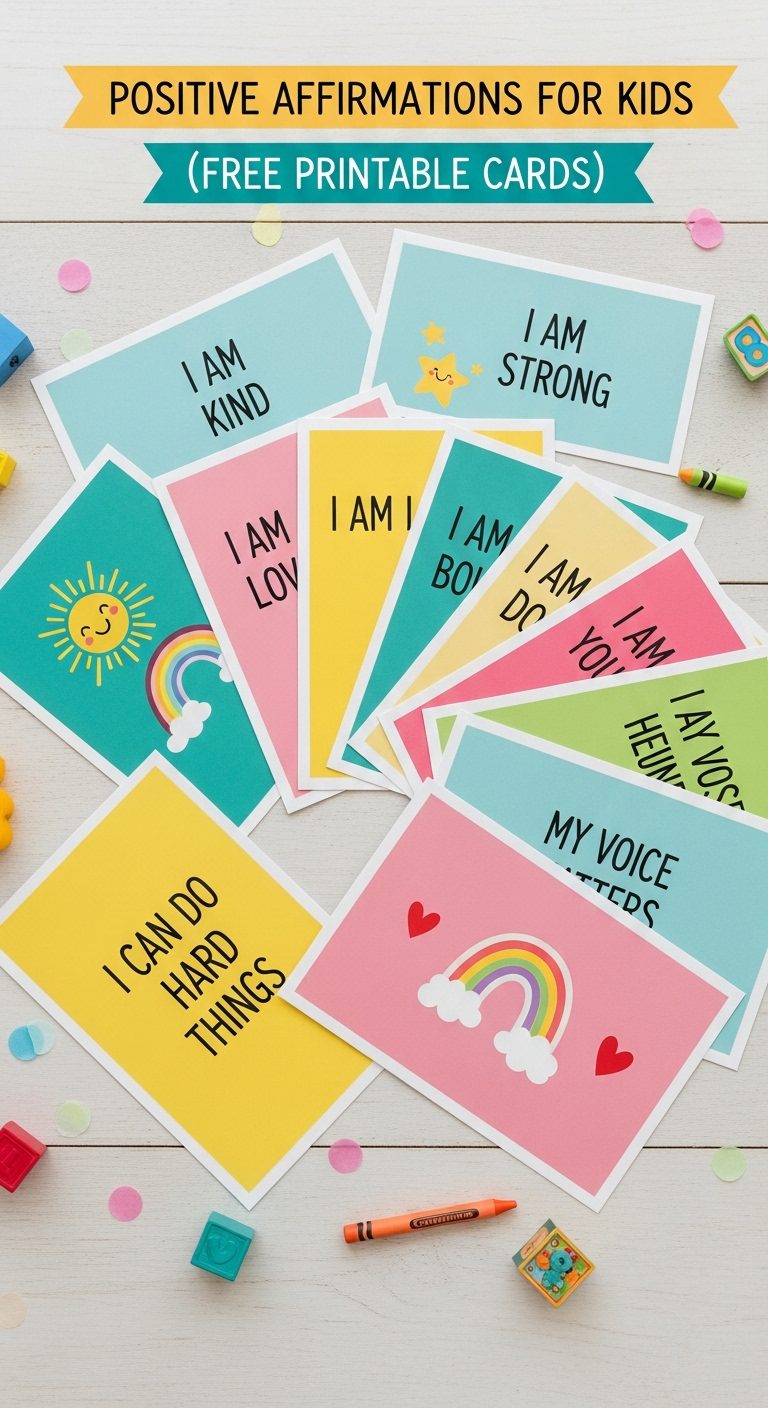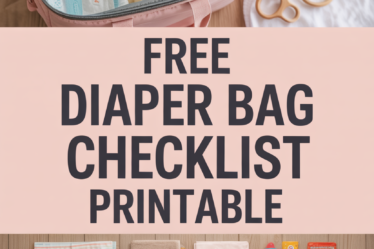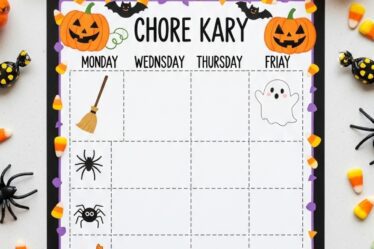
You want your kid to feel brave, kind, and capable—not just on shiny report-card days but on shoes-are-lost-again mornings. Same here. I started using positive affirmations for kids after a string of meltdowns over math and messy ponytails. We kept it short, said it out loud, and turned it into a daily micro-ritual. Guess what? Moods softened, effort grew, and the eye-rolling even downgraded to a smirk. Progress. If you want simple affirmations that actually fit busy family life (plus FREE printable cards you can tape to a mirror or toss in a lunchbox), you’re in the right place.
Why Positive Affirmations for Kids Work (and Don’t Feel Cringe)
Kids repeat what they hear. When that inner voice says “I can try again” instead of “I’m bad at this,” you watch grit show up. Affirmations give kids short, believable scripts that nudge their brain toward effort and calm. Ever wondered why tiny phrases stick? Because short + repeatable = memorable.
Key takeaways:
- Keep it short so your kid remembers it solo.
- Make it specific so the phrase fits real moments.
- Repeat daily so the brain treats it like a habit.
IMO, the magic happens when you pair words with action—say it, then take the next small step.
How to Use Affirmations (Without Making It Awkward)
You don’t need a ceremony. You need consistency. I weave affirmations into tiny anchor moments.
Morning Kickoff
- Tape a card to the bathroom mirror: “I can do hard things.”
- Say it together once. Then high-five the mirror. Silly = sticky.
School Drop-Off
- Whisper a quick one: “I try my best.”
- Ask, “What’s one brave thing today?” Keep it to one sentence.
Homework Reset
- Hit pause, take 3 breaths, and say: “I can focus for five.”
- Set a timer for five minutes. Momentum beats mood.
Bedtime Wind-Down
- Ask, “Which affirmation helped today?”
- Close with “I’m proud of me.” Short, warm, done.
Pro tip: Pair a phrase with a gesture (thumb to palm, hand to heart). That body cue helps kids find the words when emotions run hot.
Age-by-Age Affirmations: Keep It Real
You match the language to the kid, not the vibe on Pinterest. 😉
Toddlers & Preschoolers (2–4)
- Keep it 3–4 words.
- Use bright visuals and actions.
Examples: “I am kind.” “I can try.” “Big breaths help.”
Early Elementary (5–7)
- Choose concrete goals.
- Link words to routines.
Examples: “I use my words.” “I can focus for five.” “I try again.”
Upper Elementary (8–10)
- Add identity + effort.
- Invite them to pick their own.
Examples: “I solve problems.” “I lead with kindness.” “I learn from mistakes.”
Tweens (11–12)
- Respect independence.
- Use phrasing they’ll actually say.
Examples: “I can figure it out.” “I choose my response.” “I’m growing every day.”
FYI: If a phrase triggers an eye-roll, let them edit it. Ownership beats perfection.
60 Positive Affirmations for Kids (Copy, Print, Post)
I grouped these by theme so you can match them to real-life moments. Use one per week or rotate daily like lunchbox notes.
Brave & Confident

- I am brave.
- I can do hard things.
- I keep going.
- I show courage.
- I believe in myself.
- I am strong inside.
Kindness & Friendship
- I am kind.
- I am a good friend.
- I listen and care.
- I use kind words.
- I share and take turns.
- I respect others.
Growth Mindset & Grit

- I try my best.
- I learn from mistakes.
- I try again.
- I practise every day.
- I am growing every day.
- I finish what I start.
Calm & Emotional Skills
- I am calm and strong.
- I can breathe and reset.
- I choose my response.
- I respect my feelings.
- I bounce back.
- I am peaceful.
School & Focus
- I can focus.
- I ask great questions.
- I solve problems.
- I use my words.
- I learn new things.
- I love my brain.
Responsibility & Character
- I am honest.
- I am responsible.
- I make safe choices.
- I am thoughtful.
- I am helpful.
- I am a leader.
Self-Worth & Joy
- I am loved.
- I am enough.
- I am important.
- I matter here.
- I am unique.
- I bring joy.
Home & Community
- I am a helper at home.
- I am a team player.
- I speak with respect.
- I am gentle with myself.
- I use gentle hands.
- I care for my body.
Effort & Energy
- I can ask for help.
- I am curious.
- I am patient.
- I am creative.
- I am proud of me.
- I can make today great.
Want them ready to print? I made you FREE printable affirmation cards with all 60 lines in clean, kid-friendly fonts. Download the free printable cards (PDF) and print on cardstock.
How to Use the FREE Printable Cards
You can print these affirmation cards for kids on US Letter or A4 and cut along the light borders. I sized each card for small hands and lunchboxes.
Print Settings
- Paper: Cardstock (200–250 gsm)
- Color: Color or Grayscale both look great
- Scale: 100% (no “fit to page”)
- Sides: Single-sided for easy reading
Smart Ways to Use the Cards
- Morning mirror: Tape one card at kid eye level. Switch it weekly.
- Lunchbox note: Tuck a card under the snack for a midday boost.
- Backpack pocket: Slip 2–3 cards in a zip pocket for tough days.
- Bedtime basket: Let your child pick a card to read aloud.
- Calm corner: Place a ring of cards by a beanbag and a timer.
- Car clip: Hang a few on a binder ring from the headrest.
Use the “one phrase, one action” rule: Read the card, then take a tiny matching action. (Say “I can focus”, then set a five-minute timer.)
Make Affirmations Stick (Without Nagging)
Short, simple systems beat grand plans. Try one.
The 3×3 Method
- 3 breaths
- Say the affirmation 3 times
- 3 taps to the heart
Fast, portable, and zero props.
The “When–Then” Cue
- When I brush teeth, then I read the mirror card.
- When I open my lunch, then I read the lunch card.
The Weekly Theme
- Pick one theme on Sunday: brave, kind, or focused.
- Swap in matching cards all week so the message repeats.
Mini-win mindset: Praise the effort that followed the phrase. “You said, I try again, and you did. Nice.”
Troubleshooting: When Your Kid Says “Nope”
You’ll meet resistance. That’s normal. You can adjust the approach without ditching the idea.
- Eye rolls: Let them edit the wording. “I can figure it out” might land better than “I am capable.”
- Perfection spirals: Use process words: “I try,” “I practice,” “I’m learning.”
- Big feelings: Pause affirmations and focus on validation + breath. After calm returns, bring back a gentle line like “I can breathe and reset.”
- Neurodiversity needs: Pair words with visual icons or movement (wall push, squeeze ball). Some kids want quiet repetition; others need call-and-response.
Ever wondered why a different voice works? Switch speakers. Sibling, grandparent, or audio recording can freshen the cue.
DIY Your Own Affirmations (Kid-Led = Gold)
You can co-create lines that feel personal. Use this quick formula.
I + (action/quality) + (specific context)
- “I try again on tricky math.”
- “I use kind words with my sister.”
- “I can breathe when I feel mad.”
Then write the kid-created line on a blank card. Ownership turns “homework” into my thing.
Compare: Cards vs. Posters vs. Apps
I’ve tried them all. Here’s the honest snapshot.
Printable Cards
- Pros: portable, tactile, easy to rotate, cheap to replace
- Cons: easy to misplace (binder rings help)
Wall Posters
- Pros: big visual cue, decor-friendly
- Cons: fades into background after a week
Apps/Audio
- Pros: guided, hands-free, consistent voice
- Cons: screen creep, needs headphones or a quiet spot
My pick: Start with cards, add one poster by the desk, and keep one short audio for bedtime. Balance beats all-or-nothing.
Affirmations + School Skills: Easy Pairings
Tie phrases to real tasks so affirmations feel useful, not fluffy.
- Reading: “I am curious.” → Pick a new book and ask one question per page.
- Math: “I try my best.” → Solve one problem, then check the steps.
- Writing: “I use my words.” → Draft three sentences and circle your favorite.
- PE/Sports: “I keep going.” → Set a 60-second jog or 10-rep set.
- Art/Music: “I am creative.” → Try one new color or chord.
The words spark action; action builds confidence; confidence fuels better words. That loop matters.
Printable FAQ (Short & Useful)
How many cards are in the free set?
You get 60 affirmation cards sized for small hands and lunchboxes.
What paper should I use?
Print on 200–250 gsm cardstock so cards last.
Can I laminate them?
Yes. Lamination helps backpack cards survive juice-box incidents. Ask me how I know. :/
How often should we rotate cards?
Pick one card per day or one theme per week. Keep it flexible so stress stays low.
Can teachers use these?
Absolutely. Add them to a calm corner, morning meeting, or line-up routine.
Quick Start Plan (5 Minutes Tonight)
- Download the cards: Positive Affirmations for Kids – FREE PDF.
- Print page 1 on cardstock and cut the six cards.
- Tape one on the bathroom mirror.
- Read it together once tomorrow morning.
- Ask that night, “When did that help today?” Done.
Tiny steps compound. You don’t need perfect routines; you need repeatable moments that feel good.
Conclusion
You want your child to think, “I can try,” when life throws a curveball. Positive affirmations for kids give them short, believable phrases they can remember and actually use. Start small: one card, one cue, one breath. Pair words with action and let progress be messy and real. And because you have a million other things to juggle, grab the FREE printable affirmation cards and let the paper do half the work for you. I’ll be over here cheering for your kid—and for you—because this stuff looks small but adds up big. 🙂



